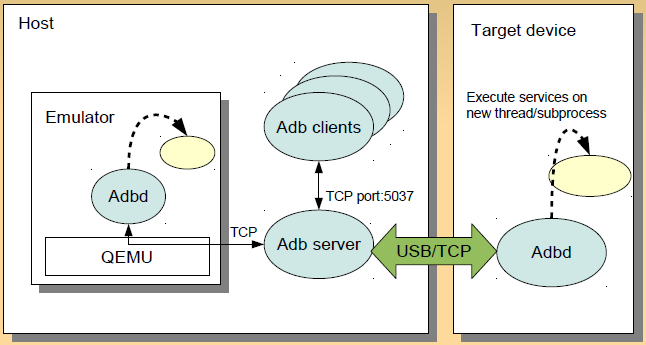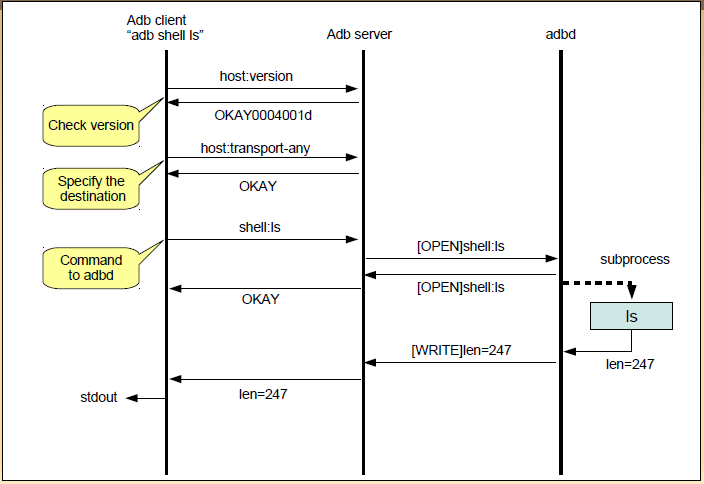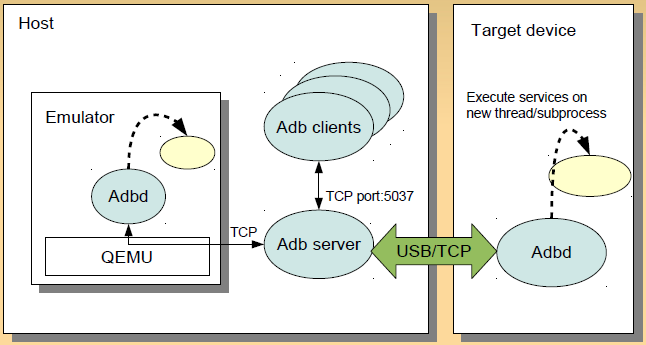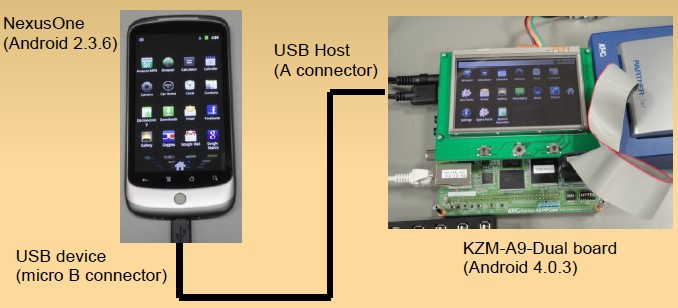How ADB works
**ADB (Android Debug Bridge): How it works? **
2012.2.6 early draft
Tetsuyuki Kobayashi
What is ADB?
- If you are an Android builder, you have used
adb logcat,adb shell. - Even if you only use DDMS in Eclipse, adb is working under the hood.
- Using adb, you can connect emulator or actual target device.
- "adb kill-server"? what does it mean?
How to connect?


2 roles of ADB
- Providing "Transport"
- communication path between host and target device.
- USE or TCP: but clients don't have to aware.
- Providing "Services"
- executing something on the target devices through the transport.
adb shellfor executing commandadb push/pullfor file transfer
- executing something on the target devices through the transport.
3 elements of ADB
- adb clients
- executable with subcommand
adb shell,adb logcat: the end point of host side
- adb server
- running on host on back-ground
- act as proxy between adb clients and adbd
- adb daemon (adbd)
- running on target device
- started by init, if die, restarted by init again.
When does adb server start?
- Explicitly
adb start-server- It starts adb server as back-ground process.
- Usually it does automatically on demand. You don't have to do
adb start-server. - When you want to restart adb server, do
adb kill-server. - Actually, adb clients and adb server shares same executable
adb start-serverequalsadb fork-server server &
ADB internal
- Source code
- How to get ADB logs
- Sequence chart
- Simple ruby script to connect adb server
- Command details
- Secure mode
- Add USB Vendor ID
- Switching transport mode
Source code
- system/core/adb in Android source tree
- From this directory adb and adbd are built
- Don't confuse
- comman files between adb and adbd
- adb.c, fdevent.c, transort.c transport_local.c, transport_usb.c, service.c, sockets.c, util.c
- files only for adbd
- backup_service.c, file_sync_service.c, jdwp_service.c, framebuffer_service.c, remount_services.c, usb_linux_clients.c, log_service.c
- files only for adb
- console.c, adb_clients.c, file_sync_client.c, usb_vendors.c, get_my_path_{linux, darwin, windows, freebsd}.c, usb_{linux, macos, libusb, windows}.c
#if ADB_HOST
/ * code for adb */
#else
/* code for adbd */
#endif
How to get ADB logs
- For adb clients and adb server, set environment variable ADB_TRACE
- For adbd, set system property
persist.adb.trace_mask.
Sequence chart

Simple ruby script to connect to adb server
require 'socket'
def error_exit
puts "Error"
exit 1
end
def send_to_adb(s, msg)
s.printf("%04x%s", msg.length, msg)
end
def check_okay(s)
(s.read(4) == "OKAY")
end
def check_version(s)
(s.read(12) == "OKAY004001d")
end
hostname = 'localhost'
port = 5037
s = TCPSocket.open(hostname, port)
send_to_adb(s, "host:version")
error_exit if ! check_version(s)
s.close
s = TCPSocket.open(hostname, port)
send_to_adb(s, "host:transport-any")
error_exit if ! check_okay(s)
send_to_adb(s, "shell:ls")
error_exit if ! check_okay(s)
while line = s.gets
puts line.chop
end
s.close
change "shell:ls" as you like.
Command details
- adb logcat
- adb install/uninstall
- adb reboot
- screen capture from DDMS
Secure mode
- Android smart phone products have adbd. Usually it runs on secure mode. (secure = 1)
- if secure == 1, change adbd as SHELL user(= not privileged), else it keeps running as root user
- In secure mode, all serivces invoked by adbd ran as SHELL user. Some causes "permission denied".
How secure mode decided
- Running on emulator -> secure = 0
- System property "ro.secure" == 1 -> secure = 1
- if "ro.debuggable" == 1, you can restart adb unsecure by "adb root"
- All Android phone products are shipped in "ro.secure" = 1, "ro.debuggable" = 0.
- See adb.c: adb_main
Add USB Vendor ID
- When connecting USB device, adb checks USB Vendor ID
- Many USB Vendor IDs are hard coded in adb.(But not enough)
- To add USB Vendor ID, make "$HOME/.adnroid/adb_usb.ini" and write one ID in one line.
- See usb_vendors.c
Switching transport mode
Switching USB mode to TCP mode
$ adb shell netcfg
lo UP 127.0.0.1 255.0.0.0 0x00000049
eth0 UP 192.168.1.139 255.255.255.0 0x00001043
$ adb tcpip 5555
restarting in TCP mode port : 5555
$ adb devices
List of devices attached
disconnected from USB. Then restart adb server with specifying target IP address.
$ adb kill-server
$ ADBHOST=192.16.8.1.139 adb devices
* daemon not running. starting it now on port 5037 *
* daemon started successfully *
List of evices attached
emulator-5554 device
Switching transport mode (What happen inside?)
- See service.c restart_tcp_service
- property_set("service.adb.tcp.port", value);
- Note: before Android 4.0, this cause "permission denied" in secure mode and ignored silently!
- After that, exit(1);
- init restarts adbd.
- "service.adb.tcp.port" is checked in adb.c adb_main
Tips
- adb emu
- adb backup/restore
- Joke commands
- Modify emulatro to allow any server socket
adb emu
- You can send a single command to emulator console easily
- send only, can not receive.
- For emulator console: http://developer.android.com/guide/developing/devices/emulator.html
- Simple example. "adb emu window scale 0.5" after starting emulator.
adb backup/restore
- New in Android 4.0
- You can backup/restore installed applications with their saved status.
Joke commands
- adb shell
- same as "adb shell" except "hell" color
- Just try.
- adb lolcat
- same as "adb logcat"
Modify emulator to allow any server socket

All server sockets in Android emulator accepts only from localhost.
If you feel inconvenient in this restriction, apply the patch in next page.
Patch to allow any server socket(for experience)
diff --git a/slirp-android/socket.c b/slirp-android/socket.c
index 439590a..ed16d5a 100644
--- a/slirp-android/socket.c
+++ b/slirp-android/socket.c
@@ -650,7 +650,7 @@ solisten(u_int port, u_int32_t laddr, u_int lport, int
flags)
so->so_laddr_ip = laddr; /* Ditto */
so->so_haddr_port = port;
- s = socket_loopback_server( port, SOCKET_STREAM );
+ s = socket_inaddr_any_server( port, SOCKET_STREAM );
if (s < 0)
return NULL;
diff --git a/sockets.c b/sockets.c
index 1063339..55b5d57 100644
--- a/sockets.c
+++ b/sockets.c
@@ -1337,6 +1337,11 @@ socket_in_client( SockAddress* to, SocketType type )
return socket_connect_client( s, to );
}
+int
+socket_inaddr_any_server( int port, SocketType type )
+{
+ return socket_in_server( INADDR_ANY, port, type );
+}
int
socket_loopback_server( int port, SocketType type )
Advanced Topics
- adb in Android device
- Port adbd to other than Android
adb in Android device
- Usually, adb is running on the host side, such as Linux, MacOS and Windows
- In Android 4.0 there is /system/bin/adb in Android file system
- What for is this?
Connect its own adbd by adb
- Restart adbd in TCP mode
- Then type "adb devices"
- It can connect its own adbd by local loop back

Connect other Android device by adb on Android

At the serial console on KZM-A9-Dual board
# adb devices
* daemon not running. starting it now on port 5038 *
* daemon started successfully *
List of devices attached
HT015P803242 device
#
It worked!
You can do "adb shell", "adb logcat", too.
Even you can install application from the board to NexusOne by "adb install foo.apk".
Port adbd to other than Android
- Quick hack!
- Consider dependency for better porting.
Quick hack!
- /sbin/adbd is statically linked executable.
- Just copy this file to ARM Ubuntu 11.10 just for experience (using Android patched kernel)
- Somehow, it worked without any recompilation
- sudo chmod 666 /dev/android_adb*
- make symbolic link /bin/sh to /system/bin/sh
- adbd runs in secure mode
- It worked "adb shell", "adb push/pull"
Consider dependency for better porting
- Some service requires other android commands
- adb install/uninstall, adb bugreport
- framebuffer service invokes /system/in/screeencap
- Adbd uses Android property system
- At the binary experiment, all property_get returns default values.
- That's why adbd ran in secure mode.
- At the binary experiment, all property_get returns default values.
- Switching adbd mode assumed that init restarts adbd process.



 浙公网安备 33010602011771号
浙公网安备 33010602011771号